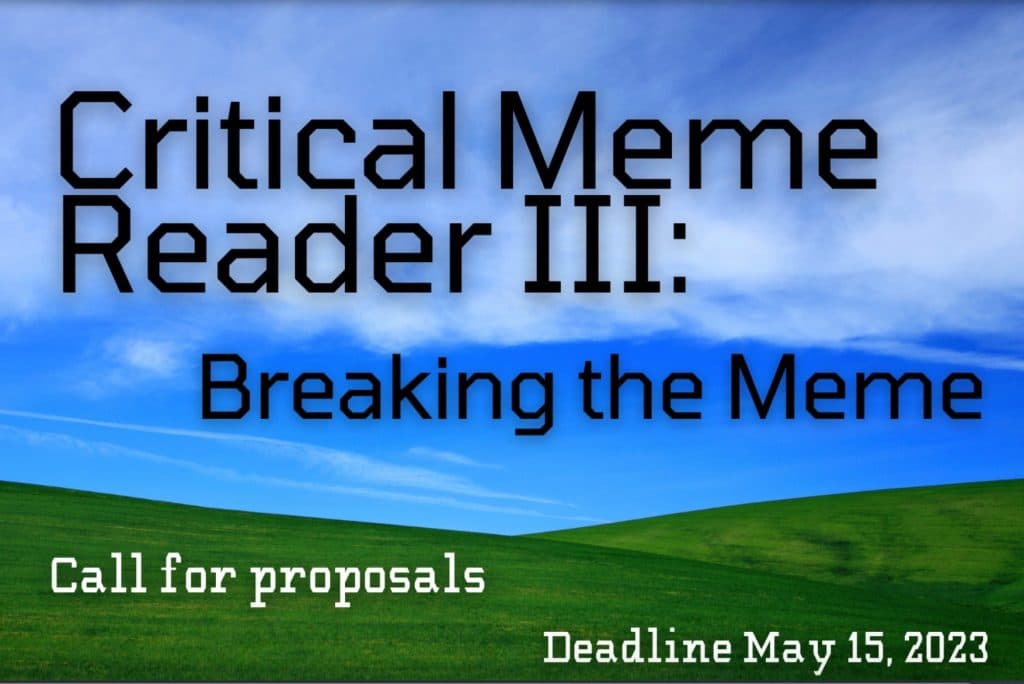Link: Viral Image Culture | Call For Proposals – Critical Meme Reader III: Breaking the Meme
Deadline: 2023-05-15
Submission Details: Proposals/abstracts should be around 300-500 words. Please send these to viralimageculture@networkcultures.org by the 15th of May. Final contributions should be 500-5000 words and submitted by the 4th of September.
Call Description:
The meme is dead. Or at least that is what opinion pieces, magazine articles, conference presentations, and even memes themselves have declared over the years. Despite this, “meme” is as pervasive a neologism as ever, used to describe a variety of digital media. Everything from bits of internet humor, image-macros, viral videos, to copy-pasta, urban legends, techno genres, dance routines and bodily gestures, have been described as memes or at the very least, memetic in nature .
Initially a niche term, the meme, particularly the internet meme, has been adopted by the online public as a way to categorize the growing menagerie of online ephemera. The widespread acceptance of the term shows that it fulfills a role in how we understand, interpret and talk about the eclectic media objects that we come across during our interactions with digital culture. However, the concept of the meme and as well as memetics as a field of study have been fraught with controversy for over many decades.
In meme studies, the foundational thinking that grounds the concept of the meme has traditionally been one that seeks to understand culture through biological models of evolution: selection, replication, inheritance. It is equally important to underline that in various global digital cultures, online ephemera had not been described as “memes” until recently, with local categorisations such as 表情包 (biao qing bao), caps, monte, and other context-specific neologisms taking precedence over the Dawkinsian “meme”. These categorisations come with their own nuanced histories and specificities and also offer us avenues to theorize digital culture beyond memes and memetics.
CRITICAL MEME READER III: BREAKING THE MEME
In the first Critical Meme Reader, Global Mutations of the Viral Image (2021), contributor Åke Gafvelin asked if there could ever be a last meme in history. We concluded that every historical event would be haunted with a memetic double – memes will be around as long as humans are around. In the second Critical Meme Reader, Memetic Tacticality (2022), we observed that memes were moving beyond static viral images, morphing and transforming. It was clear to us then that memes have speculative and revolutionary potential and as a result engender political and tangible effects in the ‘real’ world. In the third Critical Meme Reader we are taking things a step further: we are killing the meme and resurrecting it.
How can we define memes beyond Dawkins and Shifman? How can we make sense of the tension between meme activism and direct action? Do memes necessarily have to be viral and anonymous? What does it mean exactly for a meme to be tactical? How are memes evolving from 2D to 3D? Is meme making a creative (research) practice tool? What would it mean for the ways we do research if we would exchange the word meme with another word completely? Would memes still exist without the internet? What would aliens conclude about us if they would find the digital remains of memes when they discover Earth, long after humans have been extinct?
APPLICATIONS
We would like to invite thinkers and (meme) makers from a variety of disciplines and backgrounds to contribute manifestos, essays, interviews, fiction, poetry, artworks, memes and other yet-to-be-defined speculative interventions that aim to break and reassemble the ubiquitous concept of the meme. We are particularly interested in contributions from the Global South and marginalized communities and will prioritize radical perspectives.
We believe current definitions of the meme are limiting, so in order for meme studies to truly theoretically evolve as a field, the meme needs an expanded definition that moves away from neutral otological descriptions and allows for the inherent political potential of the phenomenon to be included. Billions of people make and consume memes, but no more than 100 people around the world critically reflect on the mechanisms behind these practices. With this theory deficit in mind, we ask you to redefine the meme.
Potential topics include but are not limited to:
- (Critique of) ontologies in meme studies
- Phenomenology of memes
- Memes reframed as speculative, artistic and/or activist interventions
- Global and local histories of “the meme”
- Memes as commons
- Memes and issues of copyright/authorship/recognition
- The political dimensions of meme archival
- Memes as esoterica
- Memes and (algorithmic) censorship
- Implications of the technical foundations and infrastructures of memes
- The relation between memes and physical space
- Marxist meme-labor-party-theory
- Ecology of memes
- The relationship between meme theory and meme practice
- The relevance of meme studies beyond media studies
- Meme studies and interdisciplinarity
- Memes beyond dialectics
- Entanglement between the concept of memes and the concept of time
- Alternative futures for meme studies
Please note that we will not be accepting pieces that center case studies (e.g. analyses of specific memes, subcultures, aesthetics, and communities) as their main contribution. However, we are open to pieces that seek to investigate “the meme as a concept” through examples or cases, as long as the focus is on providing fresh conceptual or theoretical insights.
INC Reader #17, Critical Meme Reader III: Breaking the Meme, will be edited by Chloë Arkenbout and Idil Galip. Proposals/abstracts should be around 300-500 words. Please send these to viralimageculture@networkcultures.org by the 15th of May. Final contributions should be 500-5000 words and submitted by the 4th of September. Contributors are welcome to join the conference in Amsterdam in April 2024 dedicated to the launch of the publication.
